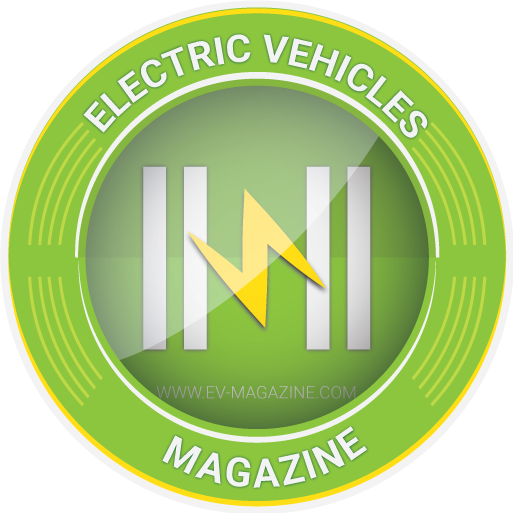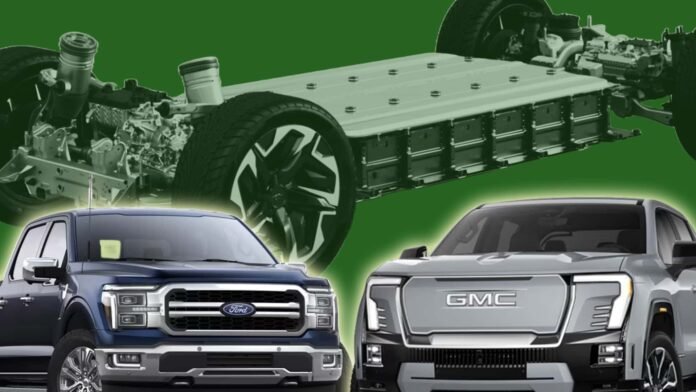There’s no question that the GMC Sierra EV can do a lot. With an estimated 440 miles of range, more power than any Sierra has ever had and towing and hauling specs effectively on par with gas trucks, it makes one of the most convincing cases for truck owners to move on from fossil fuels.
All those specs come with a big catch—literally, in this case. They happen thanks to its huge electric battery, estimated at 200 kWh or more. The same is true of the related GMC Hummer EV and Chevy Silverado EV: General Motors says its truck customers want range, and right now, the best way to do that is with big batteries.
But Ford, GM’s perennial rival in the never-ending truck wars, seems to be singing a different tune lately. In recent months, Ford CEO Jim Farley has insinuated a strategy shift around future large Ford trucks and SUVs, saying that going with big batteries to power big vehicles may always be cost-prohibitive.
Ford F-150 Lightning Production
“These huge, enormous EVs are never going to make money: the battery is $50,000, even with low-nickel, LFP chemistry,” Farley said at the Aspen Ideas Festival earlier this summer. “They will never be affordable.” Indeed, the automaker has announced it will delay a future EV truck and three-row electric SUV to 2027.
He’s been extolling variations on that idea for a while now, which is why the forthcoming Ford “skunkworks” program apparently aims to battle Tesla and China using smaller, more affordable EV options. Meanwhile, Ford’s next Super Duty trucks seem poised to go hybrid, which is where the automaker has seen a lot of success lately with the F-150 as well.
So which automaker is “right” here? And what does “right” even mean?
The conundrum represents just how much the auto industry is in a kind of powertrain Wild West as it enters a new era of electrification, which is especially challenging for the American automakers that so depend on large truck and SUV sales. Do they go with bigger battery packs like GM, or keep EVs in the smaller, more urban-centric space and explore hybrid options for the larger stuff, as Ford seems like it may do?

2024 GMC Sierra EV Denali Edition 1 exterior front three-quarter view
At the Sierra EV’s media launch in Detroit, Duncan Aldred, GM’s global vice president of Buick and GMC, told InsideEVs that he thinks his company is “in a different world” than rivals at Ford.
“We have had very different approaches than Lightning,” Aldred said, referring to the electric Ford F-150 variant. “We’re talking 440 miles plus [of range] versus competitors that are, I think, 300 and something miles. It’s just different worlds.”
Aldred said that GM does feel that trucks like the Sierra EV can be profitable, despite their large battery packs, though he declined to elaborate on whether they are currently or when and how they might be. “We’ve talked about being profitable on EVs in [Q4] of this year, and we do feel there’s a pathway there,” he said.
As for the Sierra EV, he said the specs speak for themselves: “This is a proper truck, which proper truck people will buy and be happy to use, and a lot of that is because of that range,” he said. Indeed, the F-150 Lightning’s max range tops out at 320 miles on its larger 131 kWh battery pack, and as truck folks know, that can evaporate quickly under extended highway driving or towing.
In other words, beating range anxiety is the play here, and right now, that means bigger batteries. And GM may have the advantage with how it planned its Ultium EVs.

All of its next-generation electric models are built on a common platform (which gets adapted for truck use) and use a modular family of batteries that add packs of cells to accommodate different sizes and range needs. One GM engineer told us earlier this year that this is how Chevrolet kept the Equinox EV’s costs relatively low for its class. Manufacturing scale is what will make or break EV profits, especially as automakers work to build theirs out after a century of making gas-powered vehicles.
And so far, EV profits have been elusive for both automakers. Ford’s electric Model e division reported a loss of $4.7 billion on EV sales in 2023, and while GM does not break out such results, it’s no secret that it’s been losing money going electric. For both automakers, some of that is the costs to scale up manufacturing; some are battery costs, which are going down; and other losses can be attributed to how the vehicles are designed. Either way, both companies face the same sorts of headwinds.
But the upsides and downsides to these two approaches—going hybrid at Ford and focusing on larger batteries at GM—is where these situations differ.

Ford
GM’s EVs may pack a ton of range, but in our experience, that means a lot of extra charging time. And plenty of environmental critics say that larger batteries mean more minerals, more emissions from production and more electricity to operate, making them less “green” than smaller EVs even if they have no tailpipe emissions. Meanwhile, hybrids use less gas and emit less CO2 than purely gas-powered vehicles, but they still make some—leaving many environmental advocates to insist that all-electric is the only way to go.
But in the end, there’s nothing to say that Ford won’t eventually make larger-battery electric trucks, or that GM won’t make hybrid trucks. In fact, in GM’s case, we know that plug-in hybrids are back in play. After years of shunning them as a step to be “skipped” on the way to full electrification, GM has said PHEV models are coming around 2027.
While it hasn’t said which models will go hybrid, its large trucks and SUVs are very plausible options. And with EV sales proving to be up and down and most automakers now vowing to offer “choice,” the end result may be decided by the customer.
The differing approaches by two companies located about 15 miles from each other show how much the game has changed: once, it was just about building piston-powered engines in different sizes and configurations.
Now it’s about making everything and praying that something eventually sticks.
Contact the author: patrick.george@insideevs.com
Source link by Battery Tech – News and Trends | InsideEVs
Author
#Thinks #039Big #Battery039 #EVs #Work #Ford #Isn039t








